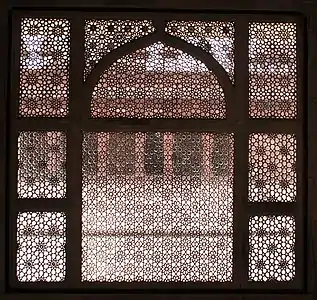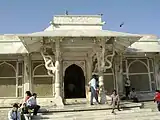Tomb of Salim Chishti
The Tomb of Salim Chishti is a mausoleum locating within the quadrangle of the Jama Masjid in Fatehpur Sikri, Uttar Pradesh, India.[1] It enshrines the burial place of the Sufi saint, Salim Chisti (1478 – 1572), a descendant of Baba Farid,[2] and who lived in a cavern on the ridge at Sikri.[3] Considered one of the finest examples of Mughal architecture in India, the mausoleum was built during the years 1580 and 1581 by Akbar, along with the imperial complex at Fatehpur Sikri near Zenana Rauza.[1] It was constructed as a mark of his respect for Salim Chisti, who foretold the birth of Akbar's son (named Prince Salim after Salim Chisti), who succeeded Akbar to the throne of the Mughal Empire.[1] Along with the Jama Masjid and the old city of Fatehpur Sikri, the tomb was inscribed on the UNESCO World Heritage List in 1986.[4]

Architecture


The tomb was constructed on a platform that is about 1 metre high with a flight of five steps leading to the entrance portico. The main tomb building is enclosed by delicate marble screens on all sides, and the tomb is located in the centre of the main hall, which has a single semi-circular dome. The marble building is beautifully carved and has an ivory-like appearance. The plinth is ornamented with mosaics of black and yellow marble arranged in geometric patterns. An ebony "chhaparkhat" enclosure surrounds the marble cenotaph, which is usually covered by a green cloth. A wooden canopy encrusted with mother-of-pearl inlay mosaic stretches over it.[5]
The door to the main chamber is intricately carved with arabesque patterns and bears inscriptions from the Quran. Brown marble borders the interior bays while the relief panels - with the Quran verses - have a blue background. The carved and painted tomb chamber has a white marble floor, which is inlaid with multicolored stones. The multicoloured stones which are also a piece of diamond ruby or emerald.
Gallery
_around_Salim_Chishti_Tomb.jpg.webp)
 Tomb of Salim Chisti
Tomb of Salim Chisti An ulama in front of the tomb
An ulama in front of the tomb Sufi singers in front of the building
Sufi singers in front of the building A closer view of the building
A closer view of the building Side view
Side view Inside work
Inside work
References
- "Fatehpur Sikri". Imperial Gazetteer of India (v. 12). Oxford. pp. 84–85.
- Schimmel, Annemarie (22 February 2022). Islam in the Indian Subcontinent. BRILL. ISBN 978-90-04-49299-8.
- "World Heritage Sites - Fatehpur Sikri (1986), Uttar Pradesh". Archaeological Survey of India (ASI) website.
- "Fatehpur Sikri". UNESCO World Heritage Centre. United Nations Educational Scientific and Cultural Organization. Retrieved 25 June 2023.
- "Indian Empire". Imperial Gazetteer of India ( V. 2). Oxford. p. 126.